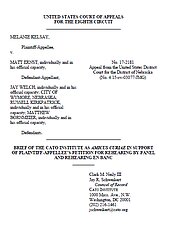Learn more about Cato’s Amicus Briefs Program.
Melanie Kelsay, her three children, and an adult friend of hers were swimming at a public pool in Wymore, Nebraska. She and her friend were engaged in what she called “horseplay,” but some onlookers thought he might be assaulting her and called the police. The police arrested her friend, even though she repeatedly hold them he hadn’t assaulted her. While in a conversation with Deputy Matt Ernst, Kelsay saw that he daughter had gotten into an argument with a bystander, and she tried to go check on her. Ernst grabbed her arm and told her to “get back here,” but released her. Kelsay then said she needed to go check on her daughter, and again began walking toward her. At that point, without giving any further instructions, Ernst ran up behind her, grabbed her, and slammed her to the ground in a “blind body slam” maneuver, knocking her unconscious and breaking her collarbone.
Kelsay subsequently brought a Section 1983 suit against Ernst, alleging excessive force in violation of the Fourth Amendment. Ernst claimed qualified immunity, but the district court denied summary judgment, holding that a reasonable jury could find that he had violated Kelsay’s clearly established constitutional rights — after all, Kelsay was a small woman standing 5 feet tell, dressed in swim clothes, who posed no threat whatsoever to anyone around her and was not even a criminal suspect, yet Ernst performed a violent takedown maneuver causing serious physical injury, all because she had the audacity to walk away from him.
But on appeal, a divided panel of the Eighth Circuit reversed, with the panel majority holding that it was not “clearly established” that using a takedown maneuver on a suspect who walks away was unlawful — simply because there was no prior case with sufficiently similar facts. One judge concurred “advisedly,” nothing that, while he agreed qualified immunity was warranted, “the slamming of [Kelsay] to the ground by the deputy with force sufficient to fracture her shoulder was uncalled for given the nature of the encounter underway.” Chief Judge Smith dissented, arguing that an exact case on point is not necessary to defeat qualified immunity when the unlawfulness of the defendant’s conduct would have been “obvious” to any reasonable officer under the circumstances — as it most assuredly was here.
Kelsay has now filed a petition for rehearing in the Eighth Circuit, and Cato filed an amicus brief in support of this petition, urging the court to address the legal and practical infirmities with qualified immunity generally. Qualified immunity was essentially invented out of whole cloth by the Supreme Court over the last half century. The text of our primary civil rights statute — usually called “Section 1983” after its place in the federal code — makes no mention of any immunity, and the common-law background against which it was adopted did not include any freestanding defense for public officials who acted unlawfully; on the contrary, the historical rule was that public officials were strictly liable for constitutional violations. In essence, qualified immunity has become nothing more than a “freewheeling policy choice” by the Court, at odds with Congress’s judgment in enacting Section 1983.
This brief is part of Cato’s ongoing campaign to demonstrate that qualified immunity lacks any legal basis, vitiates the power of individuals to vindicate their constitutional rights, and contributes to a culture of near-zero accountability for law enforcement, prison personnel, and other public officials.


